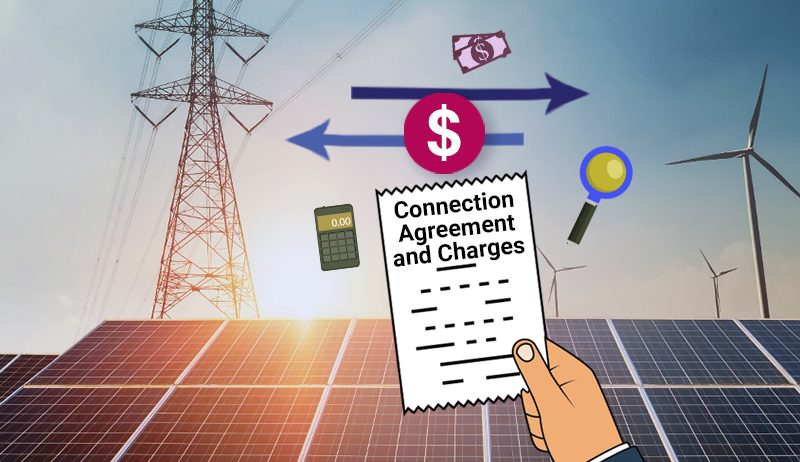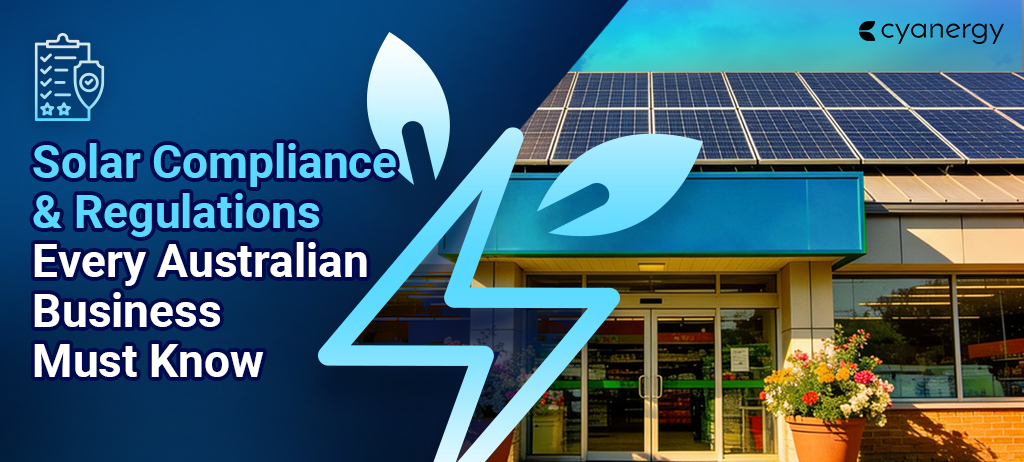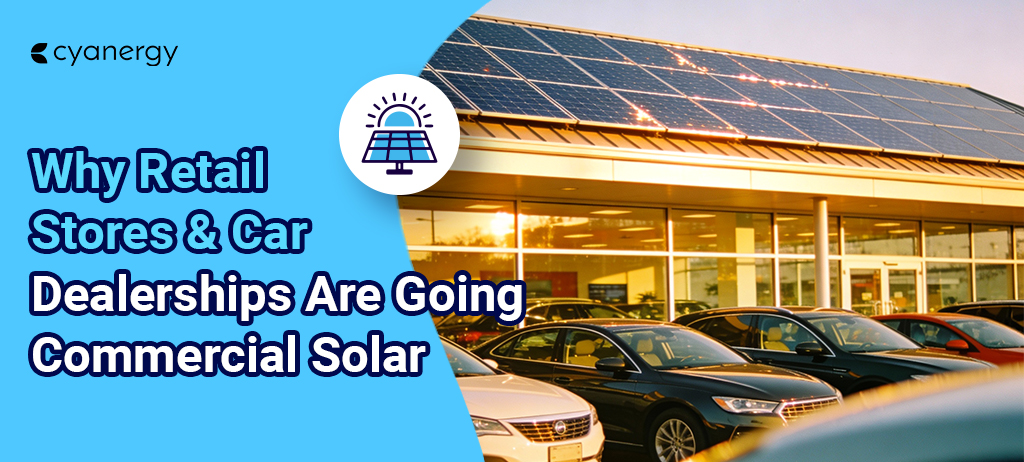Connecting commercial solar systems to the grid in Australia requires a detailed and regulated process to ensure smooth operation with the national electricity grid. This is important for businesses using solar power to save energy costs and support sustainability.
So, what’s the process of implementing grid connection for commercial solar in Australia? Let’s figure this out together!
The main steps include getting pre-approval from the local electricity provider (DNSP), following technical guidelines, making fair connection agreements, and setting up proper metering.
What is Grid-Connected Commercial Solar?
Grid-connected commercial solar systems are solar power setups for businesses linked to the main power grid. These systems allow a business to use solar energy generated by their solar panels while also being able to draw power from the grid when necessary. Here’s a simple breakdown:
Solar Panels: Installed on the roof or other suitable areas, these panels capture sunlight and convert it into electricity.
Inverter: This device changes the solar panels’ electricity from direct current (DC) to alternating current (AC), used by most commercial appliances and machinery.
Electricity Usage: The business uses solar-generated electricity first. The system automatically pulls power from the grid if the solar panels don’t produce enough electricity.
Excess Power: The extra power is returned to the grid if the solar panels generate more electricity than the business needs. The business may receive credits or payments for this excess power through a feed-in tariff.
How Does Grid-Connected Solar Work?

Most people choose solar systems connected to the main power grid because they are reliable. When your solar panels aren’t making enough electricity, your home can use power from the grid.
If your solar panels make more electricity than you need, the extra power goes into the grid, and you get paid for it. Ask your energy provider if you can send extra energy to the grid.
Grid-connected systems have two main parts: the solar panels on the roof and a special inverter that connects to your home’s electrical system and meter.
Four Size Categories for Commercial Solar Systems
1. Less than 30 kW (Up to about 100 panels)
These systems use the same equipment and rules as home solar systems. Installers who work on home systems can handle these without requiring extra knowledge.
A 30 kW system can produce about 120 kWh of electricity daily, saving the business about $1000 monthly if it uses all the power.
2. 30-100 kW
Systems this size require special equipment to protect the power grid and require permission from your local electricity provider to connect. It’s best to hire a commercial solar specialist for these systems.
These are usually installed on medium-sized office buildings, local clubs, and small retail businesses.
3. Over 100 kW
4. Over 250 kW
Process of Getting a Grid Connection for Commercial Solar in Australia
Initial Consultation and Site Assessment:
- Contact a solar installer to discuss your energy needs and potential solar system options.
- The installer will assess your site to determine the best location for the solar panels and evaluate your current energy usage.
System Design and Proposal:
- Based on the assessment, the installer will design a solar system tailored to your business and provide a detailed proposal, including costs, expected savings, and system specifications.
Approval and Permits:
- Submit an application for grid connection approval to your local energy distributor, including the proposed solar system details.
- Obtain necessary permits from local authorities, ensuring the system complies with local regulations and standards.
Installation:
- Once approvals and permits are secured, schedule the installation of the solar panels, inverter, and other necessary components.
- The installer will set up the system and connect it to your building’s electrical system.
Inspection and Connection:
- After installation, an authorised inspector will check the system to ensure it meets all safety and regulatory standards.
- Once the inspection is passed, your energy distributor will give the final approval to connect the system to the grid.
Metering and Monitoring:
- Your electricity meter may need to be upgraded or replaced to accurately measure the electricity generated and fed back into the grid.
- Set up monitoring systems to track your solar energy production and usage.
Start Generating and Using Solar Power:
- Once connected, your commercial solar system will start generating electricity, reducing your reliance on the grid and lowering energy costs.
- You will receive feed-in tariff payments or credits for any excess energy sent back to the grid.
Ongoing Maintenance:
- Regular maintenance checks are essential to ensure the system operates efficiently and continues to meet safety standards.
- Your installer will provide a maintenance schedule and guidelines for optimal performance.
By following these steps, businesses in Australia can effectively transition to using grid-connected commercial solar power, benefiting from cost savings and contributing to a more sustainable energy future.
Connecting Large Commercial Solar Power Systems to the Grid
Getting written approval from the electricity network is crucial when installing a large commercial solar system. Every solar system connected to the grid needs this approval.
Approval for Grid Connection from Your Distribution Network Service Provider (DNSP)
The DNSP is the company that owns and runs the electricity network, including the poles and wires, in your area. It connects your solar system and your home to the grid.
The process and details for connecting to the grid depend on your specific electricity distributor.
To find your electricity distributor, check the Electricity Distributor section on Victoria’s Energy website.

Pre-approval for Grid Connection
Before installing your solar system, you may need pre-approval from your distributor. This step ensures your system can be connected to the grid once installed.
Only some people can send extra energy back to the grid. Your distributor should let you know if this applies to you. Your solar retailer should also discuss any limitations on exporting energy to the grid when giving you a quote.
Approvals usually come with conditions for larger systems. For example, a 55 kW system might be approved only if it includes a device limiting its power sent to the grid, like 10 kW.
Understanding these conditions is crucial because meeting them can be expensive and require extra equipment. Limiting the system’s power export can also reduce your expected savings.
Always get a formal approval copy and seek advice from an independent consultant. Investing in a large solar system is a big financial decision, and you want to avoid any unexpected problems.
Additionally, many local councils require approval to install systems larger than 10 kW. Discuss this with your solar company and confirm it with your local council. Reliable commercial solar companies like Cyanergy can speed up the approval process.
System Components
Solar Panels
Inverters
A solar inverter is crucial for a grid-connected solar system. It converts the DC electricity from your solar panels to the 230-volt alternating current (AC) used by household appliances.
The most common type is a grid-interactive inverter, which needs the main grid’s voltage to operate. If there’s a power outage, your solar system will shut down for safety and won’t work until the grid is back.
Hybrid or multimode inverters are also available. They can work with a battery or as a grid-interactive inverter, providing flexibility. Some hybrid inverters can continue to provide power from solar panels and batteries even if the grid is down.
Key Issues to Consider and Discuss
Technical Specifications

Connection Agreement and Charges
Metering
Grid connection requires a meter that records electricity flow in both directions. Most Victorians have Smart Meters, but you’ll need an upgrade if you don’t. Talk to your distributor about this process and any potential costs.
Find more about the best commercial solar panels for businesses. Talk to an expert from Cyanergy to get a detailed understanding.







